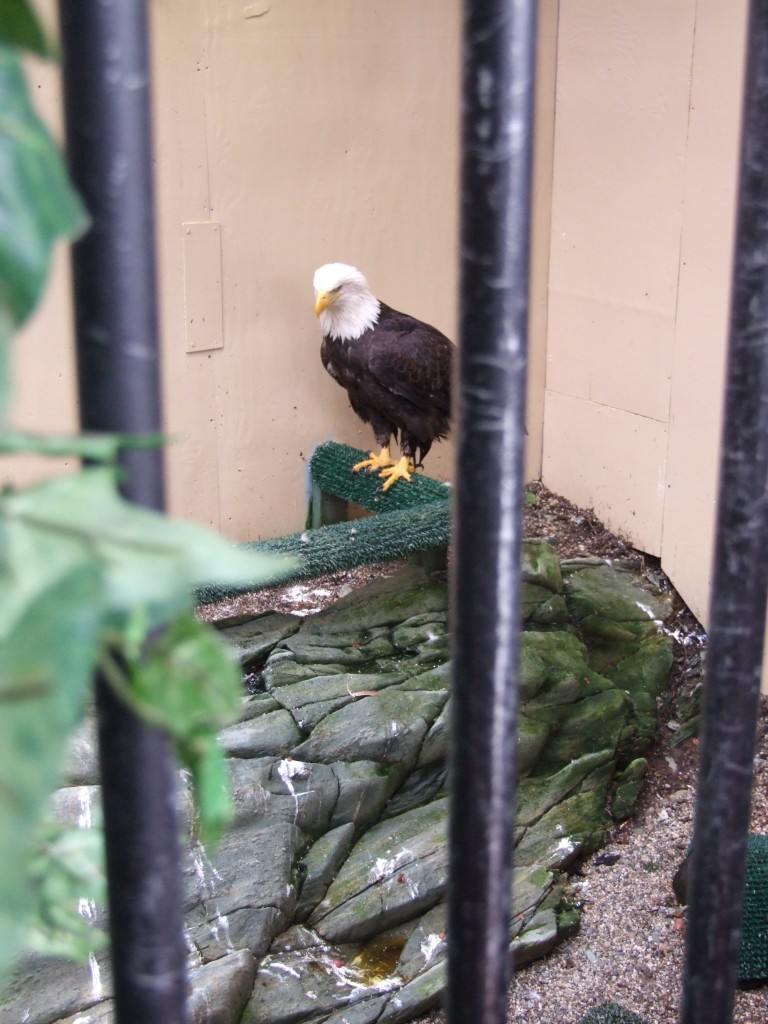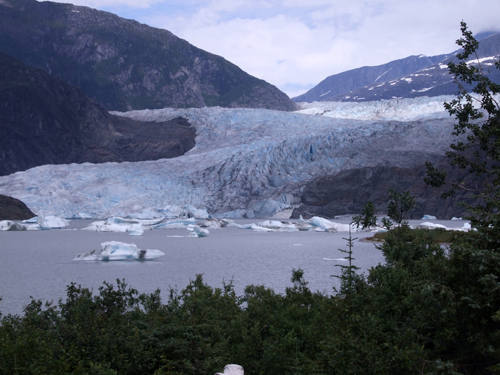
By Donald H. Harrison
JUNEAU, Alaska – Back in the summer of 1982, when daughter Sandi was 9 and son David was 7, Nancy and I purchased a recreational vehicle and set out on a three-month family vacation to explore America. One of the first “big stops” was the Grand Canyon, and, en route to Arizona, we talked and talked about what a wonder it was, how countless artists have tried to paint its majesty, and how classical musician Ferde Grofé even composed a suite about it. Little David was out of the RV in no time, and ran excitedly to a viewing point on the rim
of the canyon. When he turned around, his face reflected his grand disappointment. “It’s nothing but a big hole in the ground!” he declared. He was inconsolable.
We had made the mistake of building up David’s expectations to such a point that nothing short of, perhaps, two worlds colliding in a fantastic explosion before his very eyes, would have fulfilled his expectations. From that incident, we learned – at least intellectually, if not in perfect practice – that when dealing with children, it is better to keep expectations low so as not to cause them disappointment.
On our Alaska cruise, we thought we had followed this course with our oldest grandson, Shor, 10. However, when he viewed the Mendenhall Glacier for the first time, he turned back to us with an expression matching that of his uncle nearly 30 years before, and declared: “It’s just a big piece of ice!” He wasn’t just mimicking David; he really meant it.
It is a big piece of ice, indeed! The Mendenhall Glacier stretches for 12 miles from the Juneau Ice Field to Mendenhall Lake, according to the Juneau Alaska 2011 Guide and Travel Planner. At the glacier’s face, it measures about a half mile wide and 100 feet high, and it plunges more than 200 feet below the water line. If this is just a piece of ice, can you imagine the size of the Scotch glass that you might drop it into?
Even though Shor wasn’t impressed, Nancy and I were quite in awe upon first sighting it, perhaps because we understood that as approximately 100 feet a year of snowfall lands on the ice field, the snowfalls of previous years are compacted and solidified and begin to slowly flow downhill toward the lake—a journey that takes 80 years. The glacier scours, digs and reshapes the earth, rounding jagged mountains and scooping up boulders and dirt to form new valleys. Like a hurricane, earthquake, tornado, or tsunami, a glacier like the Mendenhall is an irresistible force of nature. And here we were, standing close to one of the most famous glaciers in the world!
Currently, the Mendenhall is said to be “retreating” – that is, there is more melting at the water line than there is accumulation in the ice fields. The net effect is that the glacier is diminished in length – some estimate by as much as 60 feet a year. This may be a cyclical phenomena , as ice fields have grown and receded several times during geologic time. But it also may be a process hastened by global warming. Is it possible, many generations in the future, that there will be no glaciers to amaze grandparents nor leave grandchildren cold?
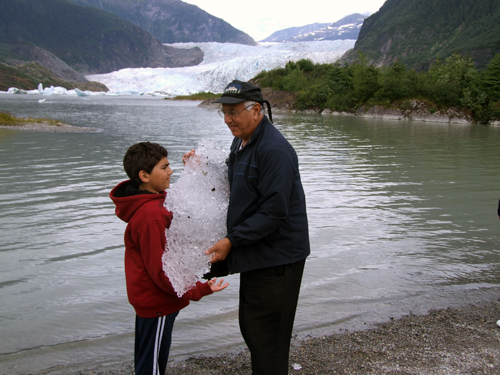
We walked down to the lake front and with a branch were able to pull a duffel bag-sized, floating piece of glacier ice toward us, holding it up in our arms in frosty triumph before easing it back down to the ground to permit another visitor to feel its cold wetness. At the shore, Shor seemed to enjoy this part of the glacier experience, leading me to conclude that our grandson is a kinestetic learner– that is a person who is
more likely to absorb information and experiences through some process of physical activity than by just watching or listening to something. School teachers are very familiar with this characteristic of energetic youth, and the good teachers try to plan lessons
that will provide an element of physicality.
Had we landed on the glacier by helicopter and tromped around on it with spiked shoes to keep us from slipping and sliding, Shor’s appraisal of glaciers might have been quite different.
There is a well known geologist named Maynard Miller who has been leading expeditions onto the ice field since 1948, sometimes staying there with his students for stretches of two months, studying the glacier in its many aspects. In a movie shown at the visitor’s center, Dr. Miller comments “When the weather breaks and it is calm and beautiful, a strange thing happens to you. You begin to sense your own minuteness and the shortness of life, and yet, at the same time, in a second, you sense the eternity of the universe
around you.”
I thought about the maxim that “fame is fleeting, and obscurity is forever” attributed to Napoleon when I learned that the Mendenhall Glacier wasn’t always named for Thomas C. Mendenhall, superintendent of the U.S. Coast and Geodetic Survey, nor was its neighbor, the City of Juneau, always named for gold prospector Joe Juneau.
Wikipedia reports that the Mendenhall Glacier was “originally known as Sitaantaagu (“the Glacier Behind the Town”) or Aak’wtaaksit
(“the Glacier Behind the Little Lake”) by the Tlingits.” It was “named Auke (Auk) Glacier by naturalist John Muir for the Tlingit Auk Kwaan (or Aak’w Kwaan) band in 1888.” As for the City of Juneau, it was initially named “Harrisburg” for prospector Richard Harris, but he had a knack for making people angry, so the townspeople decided to rename it after Joe Juneau, his
prospecting partner.
If you don’t mind some anthropomorphosis, imagine that individual patches of snow on the glacier have their own personalities. Imagine that some just slide along to their destiny, eventually falling into the lake and subsequently melting into the water – their existence irrelevant even before it was over.
Others snow patches, however, cut a rougher figure, picking up rocks, and tearing and gouging wherever they went, inspiring terrible fear among any land forms or vegetation lying in its path. Yet after 80 years of slow travel, such patches also fell into the lake, and dissolved indistinguishably from those who made no such impact.
In such ways, glaciers, animal, and human life seem to have much in common.
*
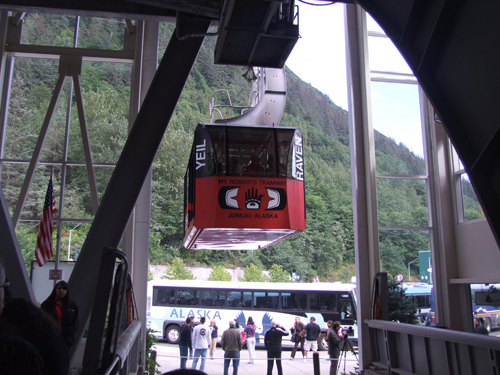
Another excursion in Juneau, more to Shor’s liking, was a ride in the aerial tram up Mount Roberts, which climbs approximately 1,800 vertical feet at a 38-degree angle, for a total distance of over 3,000 feet, to a perch overlooking Gastineau Channel and the City of Juneau. On the way up, a guide is likely to recite facts about the 400 miles of mining shafts within the well-prospected mountain, and that the search for gold in Juneau’s early years resulted in more mileage being excavated for mines than for all the roads (75 miles) and
hiking trails (250 miles) in Juneau combined.
On the way down, if you’re lucky, you might get a Native Alaskan guide who punctuates his safety announcements with his drum and songs of the indigenous people – for us, a welcome an unexpected treat.
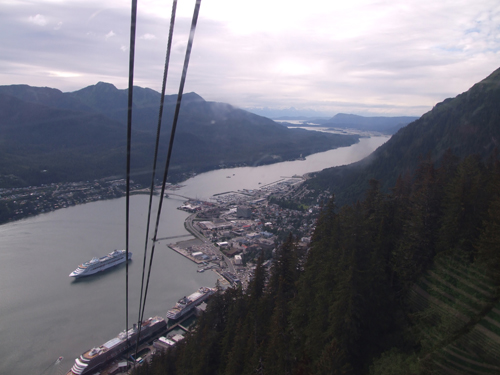
The views from the Tramway are spectacular, and it’s fun to see such ships as the Sea Princess—on which we had cruised to Juneau – from what otherwise might have been the exclusive vantage point of a Bald Eagle, which are quite common in this region.
In fact, at the top of Mount Roberts, we found one Bald Eagle named “Lady Baltimore” recovering in a cage from an accident and being cared for by the local rescue society. We were asked to pass by the Lady quietly and to refrain from using flashes with our photography.
I told Shor that apparently Lady Baltimore had been incarcerated because she was “ill eagle” but he just screwed up his face and muttered the initials “D.J.G.” which is how, with permission, he brands a “Dumb Joke, Grandpa.”
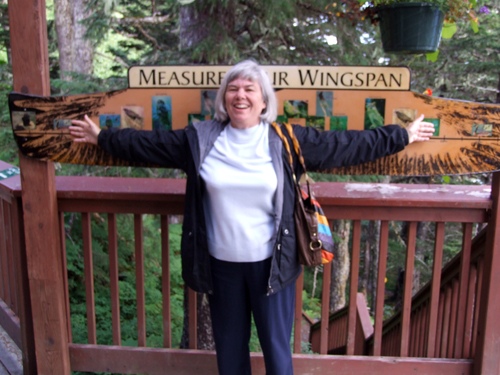
Nearby there is an opportunity for visitors to compare their arm spans with the wing spans of birds in the area, including Raven and Eagle, for which the two tram cars are named.
Mount Roberts Tramway is owned by Goldbelt Inc., a Native Alaskan business, which also operates at the top of the tramway a restaurant, bar, and gift shop. An 18-minute movie on Tlingit life and on the region is shown throughout the day, and from the tramway’s uppermost terminus are hiking trails that lead through the Tongass National Forest, which is a temperate rain forest, receiving in excess of 90 feet of rainfall a year.
From Shor’s point of view, it was a more interesting attraction than the glacier. Nancy and I enjoyed it too.
*
Harrison is editor of San Diego Jewish World. He may be contacted at donald.harrison@sdjewishworld.com File: US Canada West 15
